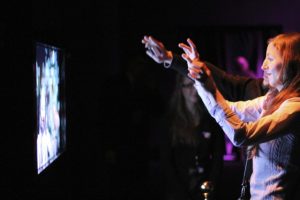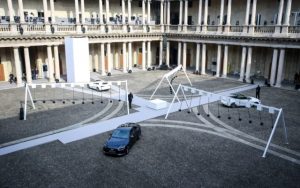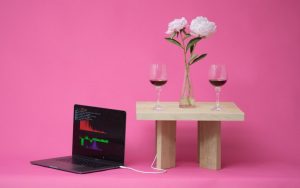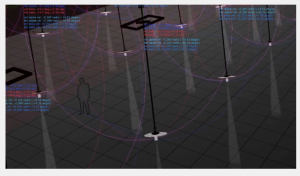afukuda-project-04
/*
* Name | Ai Fukuda
* Course Section | C
* Email | afukuda@andrew.cmu.edu
* Assignment | 04-b
*/
function setup() {
createCanvas(400, 300);
}
function draw() {
background(206, 236, 236);
var x1; // x-coordinate of vertices
var y1 = 160; // initial y-coordinate of vertices
// PURPLE LINES (THICK)
strokeWeight(1.5);
stroke(204, 178, 213);
for (var x1 = 130; x1 < 201; x1+=10) { // top-left lines
line(100, 50, x1, 120+(y1-x1));
}
for (var x1 = 200; x1 < 271; x1+=10) { // top-right lines
line(300, 50, x1, x1-120);
}
for (var x1 = 130; x1 < 201; x1+=10) { // bottom-left lines
line(100, 250, x1, x1+20);
}
for (var x1 = 200; x1 < 271; x1+=10) { // bottom-right lines
line(300, 250, x1, 420-x1);
}
// PURPLE LINES (THIN)
strokeWeight(1);
for (var x1 = 130; x1 < 201; x1+=10) { // top-left lines
line(200, 150, x1, 120+(y1-x1));
}
for (var x1 = 200; x1 < 271; x1+=10) { // top-right lines
line(200, 150, x1, x1-120);
}
for (var x1 = 130; x1 < 201; x1+=10) { // bottom-left lines
line(200, 150, x1, x1+20);
}
for (var x1 = 200; x1 < 271; x1+=10) { // bottom-right lines
line(200, 150, x1, y1+260-x1);
}
// ORANGE LINES
strokeWeight(1);
stroke(253, 205, 167);
// top set of lines
for (var x1 = 130; x1 < 201; x1+=10) { // top-left lines
line(200, 20, x1, 120+(y1-x1));
}
for (var x1 = 200; x1 < 271; x1+=10) { // top-right lines
line(200, 20, x1, x1-120);
}
// left set of lines
for (var x1 = 130; x1 < 201; x1+=10) { // left-top lines
line(70, 150, x1, 120+(y1-x1));
}
for (var x1 = 130; x1 < 201; x1+=10) { // left-bottom lines
line(70, 150, x1, x1+20);
}
// bottom set of lines
for (var x1 = 130; x1 < 201; x1+=10) { // bottom-left lines
line(200, 280, x1, x1+20);
}
for (var x1 = 200; x1 < 271; x1+=10) { // bottom-right lines
line(200, 280, x1, y1+260-x1);
}
// right set of lines
for (var x1 = 200; x1 < 271; x1+=10) { // top-right lines
line(330, 150, x1, x1-120);
}
for (var x1 = 200; x1 < 271; x1+=10) { // bottom-right lines
line(330, 150, x1, y1+260-x1);
}
// BLUE LINES
strokeWeight(1);
stroke(140, 164, 212);
line(130, 150, 200, 80);
line(200, 80, 270, 150);
line(130, 150, 200, 220);
line(200, 220, 270, 150);
// BLUE VERTICES
/*
strokeWeight(3);
fill(140, 164, 212);
point(100, 50); // primary geometry vertices (purple)
point(300, 50);
point(100, 250);
point(300, 250);
point(200, 20); // secondary geometry vertices (orange)
point(70, 150);
point(200, 280);
point(330, 150);
point(200, 150); // center of geometry
*/
}
I was able to generate this string art by simply declaring two variables: one for the initial x-coordinate and another for the y-coordinate. I began with the top-left set of purple curves, and translated those appropriately to create the geometry. Things that I could improve are: using rotation to make the code much simpler, and to use variables so the geometry becomes dynamic.
Process work:
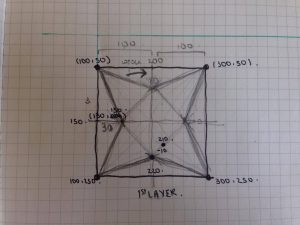
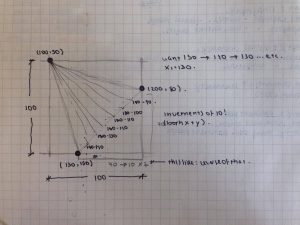

![[OLD FALL 2017] 15-104 • Introduction to Computing for Creative Practice](../../../../wp-content/uploads/2020/08/stop-banner.png)
